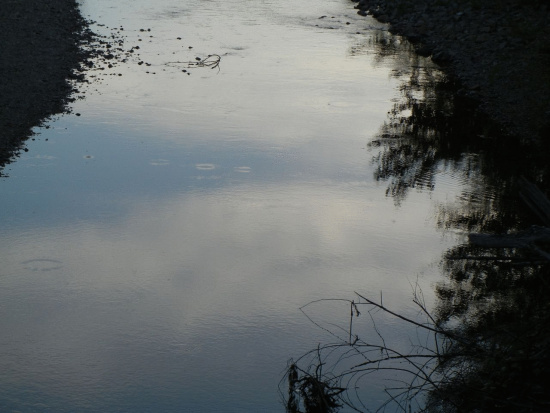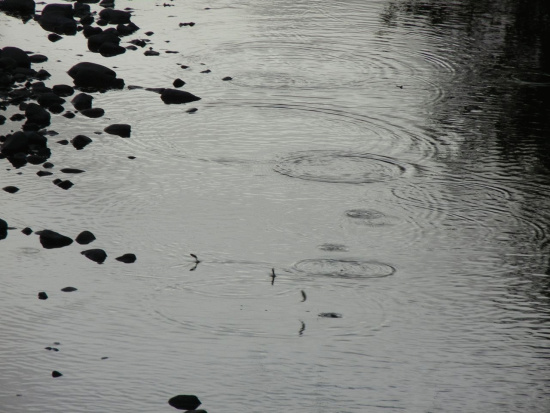Guest Post by Uti Deva:
It may not look like much in the photograph, but those tiny rings on the water’s surface are circles of life indicating that another generation of anadromous fish have successfully spawned over the winter in the creek near my cabin. For those of you who aren’t familiar with the natural history of California’s North Coast, anadromous fish are those species like salmon and steelhead trout that spawn in fresh water and migrate to the ocean to feed and grow into adults. They depend on clean cold water streams to spawn and rear their future generations. Ever since the first hunter-gatherer humans migrated here from Asia thousands of years ago these animals have been the totem symbol of this land of plenty.
It was after sunset a few nights ago and I was winding my way over the roads from my work day hooking up another water tank for a woman over on Elk Ridge. A longtime resident of the area since the back to the land movement, she was worried for the first time about having enough water from her shared spring this summer. In previous droughts there had always been enough, but times have changed and it was prudent to have enough backup stored water to get her through the late summer if the spring failed. As I drove homeward towards Ettersburg I switched watersheds from the South Fork Eel to the Mattole somewhere along Telegraph Ridge and then began the dusty miles up one of the ubiquitous SoHum dirt roads until I came to the narrow flatcar bridge over the creek before the road starts up the steep ridge to my place. I stopped to enjoy the soft light and look down from the bridge to the moving water below. It’s a peaceful way to transition from work and enjoy the moving water over the rocks while it lasts. It was also the beginning of this week’s record heat wave and the heat brought out the mosquitoes in clouds.
Late last summer was not a peaceful time at this spot. The creek had shrunk like never before in my time living here. Every young steelhead trout in this stretch of the creek, including two year olds with their rainbow stripes, eventually perished as the pools became disconnected and then shrank into warm algae clogged puddles until only one small pool was left with a handful of hardy Three Spine Sticklebacks in it. A friend and I had a token success in capturing a few hundred stranded fingerlings in the lowest pools and relocating them into the river several hundred yards away despite warnings that rescuing and relocating stranded fish was against the law. In August a nearby neighbor ran afoul of the law for pumping his water out of the dying creek in plain view and the exhaust of his gas powered pump was heard by everyone who drove over the bridge. The story was covered on Kym’s blog and in the local papers. But on this May evening nearly a year later as I looked down into the quietly moving flat water below the bridge suddenly I was aware of life moving just below the mirrored surface reflections of the last soft sunset colors. Tiny rings were randomly appearing all over the pool and here and there a tiny nose dimpled the surface. That meant new babies down there had emerged this spring and were already feeding on minute aquatic insects. It seemed like a miracle. I grabbed my camera to make a few record shots.
In the evenings around sunset it’s common for aquatic insect pupae to swim from their hiding places in the rocks on the stream bottom to the surface where they metamorphose into adults and begin their lives as flying insects like mosquitoes and other insects commonly called midges, mayflies and caddis flies. There are other aquatic insects in these moving waters that simply crawl out of the water for their final transition into air breathers like dragon and damsel flies and stone flies. It’s an awkward and vulnerable time on the water’s surface as the pupae shuck off their larval cases and unfold their fragile wings while held in the surface tension of the water and this is when the fish feed on them. Sometimes it can become an orgy of gluttony as sun energy first trapped by single cell plants moves up the food chain from grazers to predators. Fly fishermen call the event the “evening hatch” and on trout streams it’s the time fish are most active while anglers do their best to fool the trout into taking an artificial fly that looks something like the natural insects at that stage of life with a hook.
The fish I was seeing feeding below the bridge are probably young Steelhead Trout or Three-spine Sticklebacks. Back in December and January with no significant rain events and a storm blocking ridge of high pressure parked off the Pacific Northwest coast I was worried if any fish at all would spawn this year in Mattole Canyon Creek because of the drought and low water conditions that had existed since the first rains in September returned flowing water to the creek channels. I had walked along the creek bordered by a friend’s land to try to spot adults but never saw any evidence they had entered the creek. But there below me in the fading twilight was proof a male and a female of whichever species made it up the shallow sediment choked braided channels at the mouth of the creek and were successful in laying eggs that hatched. Part of me was hoping they wouldn’t bother, knowing how little rain we were getting and what the hot dry summer ahead is likely to bring. The other part of me is in awe of the resilience of these species in the face of adversity and the survival strategy programming of their DNA to never give up playing the odds that at least one male and one female will survive to return here to spawn again. The odds aren’t good because the deck is being stacked against the fish by the other two players: record drought and human water diversions at the time of the year when zero rain falls here.What will happen this year? The juvenile fish in the recent photo I made are probably doomed by the extreme low rainfall in the watershed and the volume of water being withdrawn by people in the summer from the springs and branch feeder creeks in the watershed to irrigate marijuana. Very soon the creek flow will subside and the mouth of the creek where it enters the river will show no surface water preventing any fish from escaping to the safety of the river. As the flow drops further the pools in the creek will become disconnected from each other and wherever the fish are located is going to be home for three to four months until rain returns to set them free or the pool dries up and they all perish due to predation. From my experience last summer the fish are caught by herons, egrets, raccoons and other opportunists long before they succumb to lack of water to breathe. I never found a dead fish, only the tracks of the animals that caught them around the shallow puddles. For the fish in the creek their survival is totally dependent on the water seeping out of the hills into the gravel bed of the creek to keep them alive until significant rain falls. Those springs and branch creeks on the hills above the creek are the lifeblood of the fish nursery in the pools of the main creek.
I think of a watershed as a big convoluted sponge with the creeks at the lowest point of the valleys. All the rain that falls on the sponge saturates it and the water drains out slowly at the bottom into creeks that flow to the bigger river. This year the sponge around me has a little more than half of normal saturation—-only 48 inches of rain has fallen at my cabin. There just isn’t going to be enough in the sponge for both humans and fish by mid summer and if last summer is any indication, the fish will be the losers again. I wonder to myself how many years in a row can they lose and not suffer irreparable harm?
We don’t have a water shortage problem—-we have a water management problem.Some environmentally responsible growers in the watershed have been putting in large water storage tanks and filling them this past winter when, even in this drought year, runoff water was abundant right after the major storms dropped their loads. In the summer these growers will not withdraw any water from the springs on their land, creeks or pump from the river itself. I’ve worked on more storage projects this year than any other year in the past, have seen some larger scale storage projects and have seen that this year more people will be 100% winter water growers than last year. Not enough I fear. Some growers do it out of a sense of environmental responsibility and some do it out of self-interest to be assured they will have pounds of buds come harvest time and some act out of fear that evolving law enforcement tactics may chose to target growers who do the most environmental harm over growers attempting to move towards compliance with water laws—-the fish don’t care which, their whole lives become a matter of having enough cool water to carry enough dissolved oxygen to breathe and finding a deep enough place to conceal themselves from predators like herons and kingfishers.
The North Coast is still a place of abundance and people can have an abundance of weed and salmon too by storing water in the winter and early spring when the rainfall runoff is high and by employing a few basic growing techniques to mitigate environmental damage such as outlined in Best Management Practices—-A Grower’s Guide. Even with the current lower wholesale price for marijuana, people growing for profit can still afford to do the things that will lessen their impact on the environment.
I realize that preaching the gospel of responsible management practices doesn’t begin to address trespass grows, where the players will never care about their impact on the land, or in the case of large grows on private land where the irrigation needs of large numbers of plants exceed the practical limits of storage tanks to store 100% of their water and the next step up in mass storage are ponds. Nor am I attempting to cover the issues of water rights, regulations and permits the government wants all water users to have and how reluctant growers are to come into the fold and expose themselves to the authorities who once tried to eradicate and imprison the industry into submission and who can’t guarantee amnesty from prosecution for cultivation. We all need a truce and the fish need a truce so they can survive.
No flowing water in the small creeks in late summer means a lost generation of fish and a totem species that has been a cornerstone of our world is threatened with extinction. The quality of our lives, even though many of us who live here don’t realize or understand it, will be diminished should we lose.


CLICK TO MANAGE